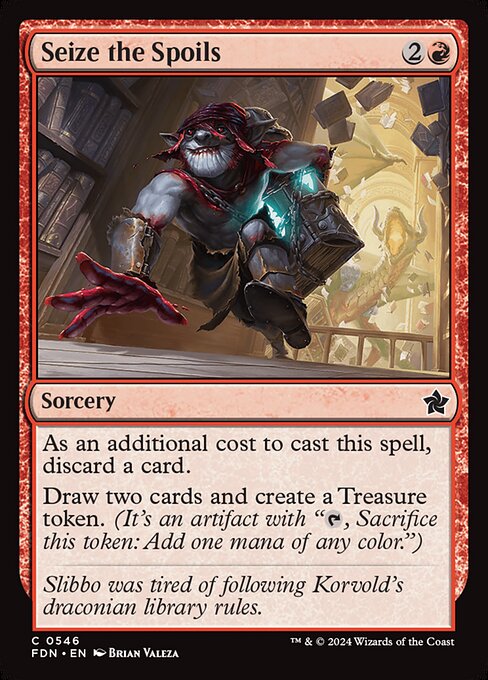
Image courtesy of Scryfall.com
Unraveling the Seize the Spoils Illustrator's Enduring MTG Legacy
In the pantheon of MTG illustrators who quietly shaped our sense of wonder, Brian Valeza’s work on Seize the Spoils stands out as a vivid reminder that a single image can hinge a card’s personality, gameplay fantasy, and even a few casual conversations at the kitchen table. The Foundations set brought with it more than a handful of reliable staples, but it’s Valeza’s red-splashed flourish on this sorcery that still gets readers leaning in—asking not just what the spell does, but what it says about a moment when risk meets reward 🧙♂️🔥. The art feels like a doorway to a back-alley deal in a war-torn bazaar: the tension of a discarded card, the gleam of treasure, and the surge of color that tells you something deliciously unpredictable is about to happen 🎲.
Mechanically, Seize the Spoils is a compact engine for red creativity. Its mana cost—2R—demands an early, honest investment, and the twist comes with an additional cost: discard a card. That small cost is a signature red move—trade resource for momentum. And then the card delivers a double-dip payoff: draw two cards and create a Treasure token. Treasures are quintessential MTG ramp in a bottle, a token artifact that, when sacrificed, grants one mana of any color. It’s a mana-multi-tool that can power big plays, combo lines, or simply accelerate a red deck’s tempo. In practice, you might chain Seize the Spoils with other draws or discard outlets to snowball into a dizzying late-game sprint 🧙♂️🔥💎.
From a strategic angle, Seize the Spoils rewards a player who’s not afraid to gamble with their hand. The discard-as-cost mechanic is a deliberate nod to the way red trades certainty for speed—sacrificing certainty for acceleration. The two cards drawn offer immediate value, while the Treasure token provides a flexible resource to fuel pivotal spells or a critical turn of mana when you need to cast multiple spells in a single turn. In Commander circles, that ramp is especially potent, because it can help a red mage stabilize after a sweep, or push a treasure-focused archetype toward the critical mana threshold for a game-ending commitment ⚔️. The card’s rarity—common—speaks to Foundations’ design intent: it’s accessible, it loans energy to a broad slice of decks, and it invites players to experiment with tempo and resource recoupment without breaking the bank 🎨🎲.
Flavor, lore, and the illustrator’s hand
Flavor text on Seize the Spoils—“Slibbo was tired of following Korvold's draconian library rules.”—adds a sly wink that reframes the spell as not just a mana-boosting trick but a rebellious moment in a larger magical world. It’s the sort of line that invites not just chess-like strategic thought but a giggle about the undercurrent of MTG’s stories. Valeza’s illustration captures that sense of audacity in motion: a cascade of red glow, a gleam of gold—treasure ready to be claimed—paired with a dynamic angle that makes the viewer feel like they’re the one crossing the line from plan to payoff. That sense of moment is the essence of enduring MTG artwork: it tells you a story you’ll carry into the next game, the next draft, or the next tournament night 🧙♂️💎.
The legacy here isn’t just about one card; it’s about a style that aligns with red’s love of risk, improvisation, and opportunistic gain. Valeza’s approach—strong contrast, kinetic composition, and a focus on the emotional beat of the moment—resonates with players who savor the thrill of a well-timed draw or a last-minute turn that makes a difference. Across the MTG timeline, illustrators like him helped push the visual language of magic into more kinetic and story-forward territory, where a card’s art could spark a thousand tabletop conversations and spark ideas for deckbuilding that go beyond raw numbers 🔥🎨.
And there’s more than nostalgia at play. The card’s Foundations roots remind us that even “core-like” sets can carry bold, memorable art that ages well as new mechanics emerge. The Treasure mechanic, now a staple in many decks, still feels fresh when reimagined through Valeza’s lens. The combination of discard, draw, and treasure has proven to be a surprisingly durable recipe for red’s impulsive flavor: take a chance, reap the reward, and maybe conjure a little gold along the way 💰⚔️. It’s a reminder that good design isn’t just about raw power; it’s about crafting experiences that feel both thematic and playable with equal swagger 🧙♂️.
Collectors and players alike appreciate Seize the Spoils for its accessible rarity and its ongoing ability to slot into multiple strategies. In the current market, the card remains a dependable pick for those exploring Treasure synergies, or simply for fans who want a bold, story-rich card in their collection. The art, the text, and the moment all work together to create a small but enduring ripple in MTG’s vast tapestry, a ripple that keeps surfacing at the table when someone cashes in a Treasure and laughs at the color-splash of opportunity ⚡💎.
For readers curious about how this legacy ties into broader MTG culture, the five linked essays in the network offer a spectrum of perspectives—from control matchups to green-green synergies, and from grading the market’s fluctuations to examining player immersion. They’re a perfect companion read when you’re savoring Seize the Spoils’s blend of risk and reward with a mug of coffee beside the foil of your favorite deck.
Clear Silicone Phone Case - Slim & Flexible with Open PortsMore from our network
- https://blog.digital-vault.xyz/blog/post/mastering-agent-of-masks-control-matchup-tech-explained/
- https://blog.digital-vault.xyz/blog/post/fyndhorn-bow-synergies-top-green-commander-combos/
- https://blog.rusty-articles.xyz/blog/post/grading-magic-how-psa-and-bgs-impact-murderous-rider-swift-end-value/
- https://blog.digital-vault.xyz/blog/post/thundercloud-elemental-balancing-competition-with-spectacle/
- https://crypto-acolytes.xyz/blog/post/unpacking-the-science-of-player-immersion-in-games/